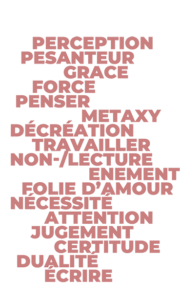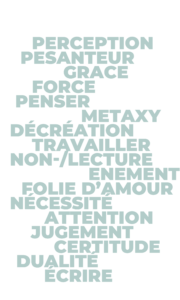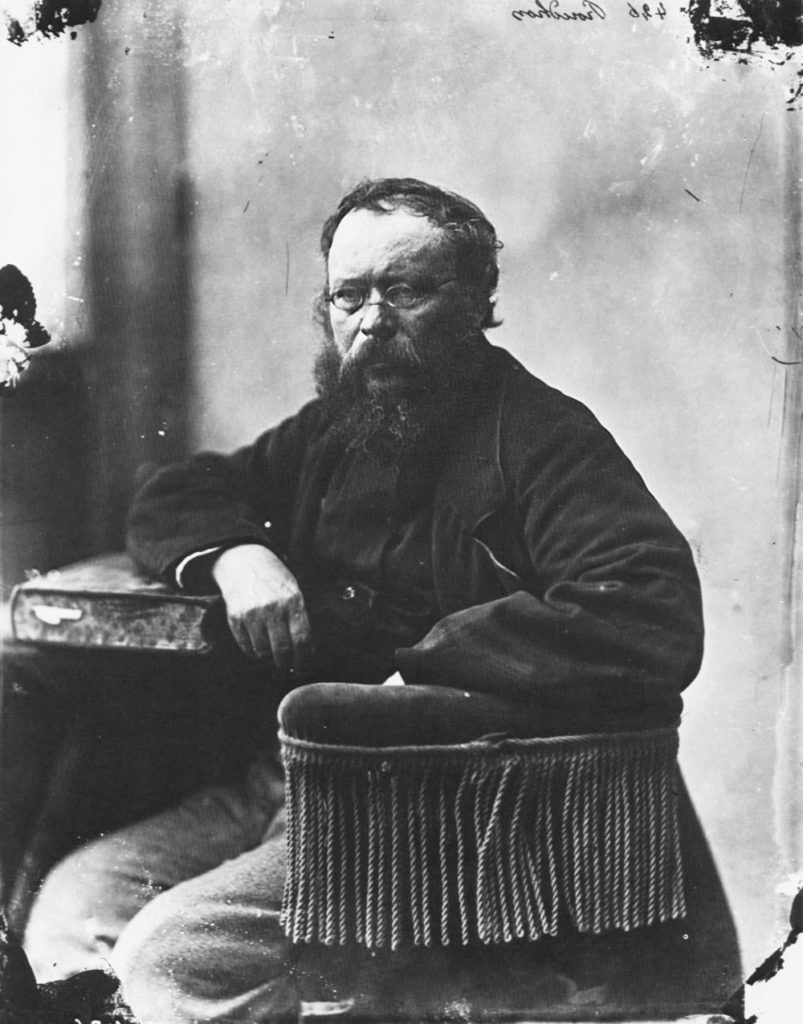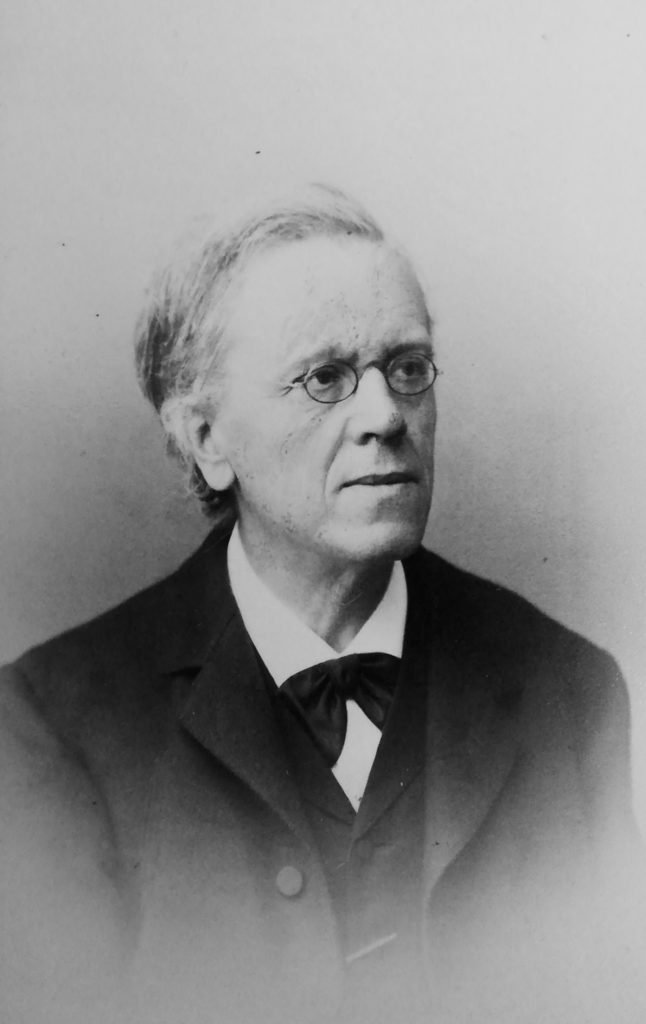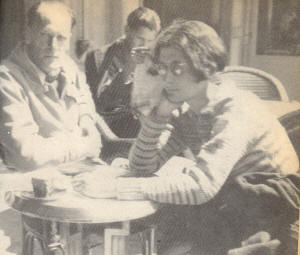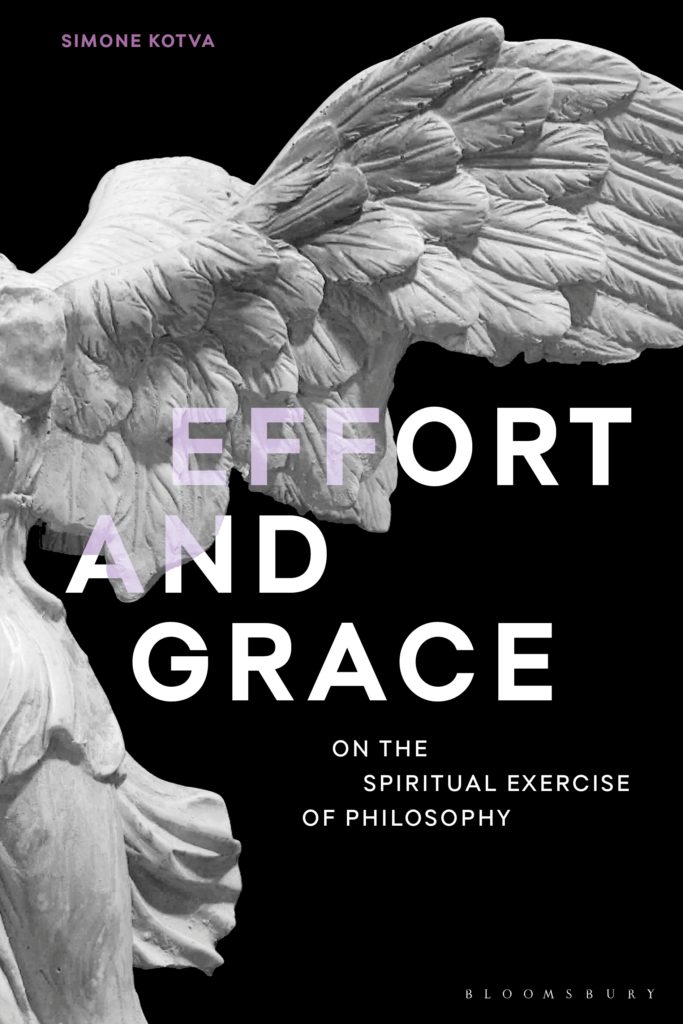Il dansait, il dansait toujours, le peuple des âmes candides, des âmes des enfants qui ne sont pas encore nés; attendant leur tour d’être des hommes, les lutins se poursuivaient sur les bûches crépitantes.
Simone Weil, Les Lutins du feu, 1921/22.

ELISABETH HUBMANN

Abstract
Elisabeth is an organist, musicologist, and environmentalist active in Genève, Amsterdam and elsewhere. Her research focuses on historical and modern organs, as well as keyboard instruments and their practice. In addition, she works on improvisation, interdisciplinary projects and ethnomusicology. Active in classical and experimental performances, Elisabeth emphasises contemporary organ music in her work to promote a new openness and transdisciplinarity in cultural-artistic and scientific-discursive settings. Moreover, she explores the intersections of anthropology, cultural heritage, listening practices, instrument making and lived, practice-oriented research. As a performer, she loves to play a broad repertoire from early to contemporary music on organ, fortepiano, and related keyboard instruments.
“Les Lutins du feu” is probably the earliest work by Simone Weil, written when she was about 12 years old. Elisabeth Hubmann conducted several improv pieces on organs in response to Weil’s “first poetry”.

T (Tom of the Denkkollektiv): We have received a very precious yet unusual gift from you: an audio file with organ music. What does one hear when listening to it?
E (Elisabeth): One can hear many different things, depending on what they focus on. If listening while reading Weil’s poetry, one might be shocked by the conflicting setting of music in relation to the text. One who concentrates on the music might be trying to distinguish electronic sounds from organ sounds and to understand the layering of the improvisations. One who enjoys simply listening might be overwhelmed by the masses of sound.
T: “Les Lutins du feu” is one of the lesser known texts by Simone Weil. Some Weil scholars assume that it is her earliest text available to us, probably written in 1921, when Weil was about 12 years old. How was your first impression of this text? Did you recognise the young age of the author?
E: The text fascinated me very much, yet I was confused and I couldn’t construe it. I did not know many other texts by Simone Weil before, but I recognised that this one is very special, probably unusual. It was the most colourful text I had read in a long time and yet I felt it is set in darkness, sometimes scattered with little lights – when I read the text now, I feel the colours are much brighter than in my improvisations.
T: What happened after your first encounter with the text? The final product we can now listen to consists of a recording of an improvisation that is a live, spontaneous act you have performed. Additionally, it is more than just the simple documentation of this unique “event”. You amplified the recording in a manifold process of “post-production”. So, we have several layers of reception, (re-)action, reflection, editing, alteration, and I guess, imitation?
E: This was the first time someone asked me to improvise on a text. My spontaneous reaction was to read the text many times, underline words that provoke something in me and try to find sections that could help me to structure my improv. I thought about using musical language contemporary with Simone Weil, a composer that reminds me a bit of her: Jehan Alain. His music is as colourful as Simone Weil’s text and he was, as was she, very passionate, also in his christian faith. I wrote a scheme with key words and sections and chose organ stops to put the words into music, but soon I gave up modelling my work after Alain – his music is unattainable and I didn’t want to rationalise the process even more. I opted for an organ from 1918 in Amsterdam, (where I used to be an organist), so quite close to the origin of the text. Today, it has a typical electro-pneumatic action but its sound gives us us an idea about the typical soundscape in the early 20s. I played the music spontaneously from that point onwards, there was some “good” music and some “bad” that came out. First and foremost, I am a player, not an improviser, so I felt I had to gain a bit more control by doing further creation with this material. Also, I had to let some time pass. I sat down at another organ, this time in Geneva, to complete the material with what, after listening to the first set of improv pieces, I felt was missing. In the meantime, I experimented the melting together of organ and synthesizer with a composer-friend and I thought of our recordings to be very apt for an ambience for this Weil text. After giving up the idea to put the text “literally” into music, instead I recreated my feelings from when I was reading the text, meaking music at the centre of my endeavour. For a long time I felt especially impressed by the darkness and gloom, interrupted by scenes of light games like shimmer, burning, flashing and noises like crackling, sighing and whining. So I put these 3 experimentation situations together and worked on a dramaturgy without a clear story line, but reflecting the scenes of dance, sobbing, fight and fire, enveloped by tranquillity.
T: After listening to your improv pieces I started to read “Les Lutins du feu” in a non-chronological, non-linear way. That means that I did not read the single figures, events, elements set along the dominant storyline but the initially apparent storyline as being opened, enmeshed, short-circuited by manifold agents of light, fire, and fight.
E: First I thought the storyline would be the same as in my improv. But the wild fury dance, as described in the text, was hard to begin with. I tried several times, but never to my contentment. I also felt it is a bit too simplicist and childish for this text to translate words in notes and sentences in musical phrases. And finally, dance is a form of movement and movement in music needs preparation. Still, I can recognise the story in the music, but as you say, in a less black and white, but a more complex and rich way; in associations, amalgamations, re-interpretations. The fire that strikes down from the sky and the fight of Mégistos are combined in a similar musical idea, as are the questioning and whining. Dance is movement, sometimes in the foreground, but mostly as a swarming in the rear.
T: Against the backdrop of some critics dismissing the text as children’s artistry, it is very interesting that you explicitly felt to do something that counters all impressions of childish poetry. Was there something unsettling, irritating, provoking in the text that supported your impulse to not go too easy with it?
E: Yes, “simply” the impression it made on me! We tend to judge art and many other things very often in an academic way, according to cultural, formally transmitted criteria that blind us from what we actually feel. Meanwhile, popular arts have understood very well that what counts is what it provokes and not if it is done with highest artistry or great complexity.
T: Did you “invite” other influences into your process of making music? Other composers, models, thematic elements or musical inspiration from elsewhere?
E: Yes, it is best audible in the beginning of the piece. A synthesizer leads the way with acidity, blending into more and more levels of organ sounds. Also, the metallic percussive sounds are generated by my friend Nicolas Roulive on the synthesizer. I added some filter effects on some of the pure organ sounds as well, others I left just as they are. Talking about influences, it is often hard to name why we do things one way or another. I am inspired and marked by many different schools, teachers, composers and improvisers, but I’m neither a composer nor an improviser, but for the moment a musician trying to leave the cage of an interpreter. On a note not directly related to music, my encounters with nature, sonorities of the environment, human noises, travels, and (other people’s) characters have a huge impact too.
T: Finally, what do you recommend: Reading the text first and then listening to your improv pieces or the other way around? Or simultaneously, or both in a repetitive, or even meditative manner?
E: What experience do you want to have? An intellectual one? A meditation as you say? It will be a very different impression in what order you read and listen. And especially how you read and how you listen. My recommendation is to be open for confrontation and looking for a positivist effect: to learn or realize something, to allow feelings, to discover pretty atonal, cloudy, noise-music and appreciate a musical approach to Weil that is different from what you might ever have heard before.
LES LUTINS DU FEU
Le bal allait, allait… Les lutins sautaient leur joyeuse sarabande, plus haut, toujours plus haut. Les robes de lumière se frôlaient, rouges, jaunes, orange doré, projetant tout autour des lueurs fantastiques. Il dansaient, les lutins de flamme, sur les bûches craquantes et le bois fendu, ils dansaient avec ivresse, bondissant et s’entrechoquant.
Il dansait, il dansait toujours, le peuple joyeux des « Phlogos », conduit par le plus grand, l’empereur, le « Mégistos ». Ils sautaient en le suivant, s’arrêtant parfois pour baiser ses pieds brûlants.
Il dansait, il dansait toujours, le peuple des âmes candides, des âmes des enfants qui ne sont pas encore nés; attendant leur tour d’être des hommes, les lutins se poursuivaient sur les bûches crépitantes.
Tout à coup, une grande lueur s’éleva, et tous jetèrent de brûlantes étincelles : au-dessus du feu flambant, une flamme avait élevé sa tête altière. Et, dans les crépitements, on entendit ces mots : Phaidros Mégistos estin. » « Phaidros est Mégistos. »
Et la tête brillante de Phaidros s’illumina de fierté, tandis que tous, petits et grands, lui baisaient humblement les pieds, lui demandant : « Quel est ton bon plaisir? »
Il donna alors la main à sa belle fiancée, Chrysè à la robe d’or, et dansa une « orchèsis », la danse la plus exquise des Phlogos, où l’on ne distinguait que des tourbillons de flammes bleues, rouges ou dorées, où l’œil ne pouvait les suivre, où tous se confondaient dans une poussière enflammée.
Tout à coup, tout devint obscur, et une voix sanglotante cria en crépitant : « Phaidros Mégistos n’est plus! Phaidros Mégistos est mort! »
La danse cessa, il n’y eut plus que des sautillements saccadés; tous laissèrent là leurs couleurs brillantes et revêtirent leurs robes de deuil, d’un bleu livide. Ils pleuraient silencieusement des larmes d’or.
Après quelque temps, tous recommencèrent à danser, sauf Chrysè, ayant à leur tête le lutin Képhalè.
Mais par instants, au milieu des éclats de rire, des sanglots désespérés se faisaient entendre.
Soudain, des centaines d’étincelles sanglantes s’abattirent sur les danseurs, lancées avec une telle force qu’elles les obligèrent à se prosterner. Tous devinrent livides de peur. Quand tout d’un coup, on vit derrière une bûche la tête du lutin Klétès, qui portait le talisman de Phaidros. Car vous savez bien, mes enfants, que tout Phlogos porte sous sa robe le talisman qui lui donne sa hauteur, sa couleur, sa beauté, et que le vol en est puni de mort. «
A-t-il volé le cadavre ? » s’écria avec horreur Chrysè en s’avançant vers la bûche. Mais les étincelles l’obligèrent à reculer.
Et tous, blêmes, entendirent le bruit d’une lutte acharnée. Et tout à coup s’éleva une ombre d’un bleu livide, tandis que, fermant les yeux, tous s’écriaient : « Le fantôme de Phaidros! » Quand ils les rouvrirent, l’apparition avait disparu.
Tout, alentour, était plongé dans l’ombre. Seules, les cendres étaient rouges.
Bientôt, les étincelles cessèrent, et les Phlogos crièrent miracle : car Phaidros apparaissait, plus brillant que jamais.
Éméra, en effet, l’avait étourdi, mais non tué, et lui avait pris son talisman. Quand il reprit ses sens, ils se battirent; Phaidros, dépouillé de sa robe, dut fuir un instant vers le bal, mais bientôt se jeta sur Éméra, et l’égorgea.
Phaidros se jeta dans les bras de sa belle fiancée à la robe d’or (ce qui est le mariage des lutins) et ils dansèrent une « orchèsis » endiablée, allant plus vite que le vent, jetant des étincelles, où l’on ne pouvait les distinguer, où ils étincelaient, voilés par une poussière d’or.
Weil, S. (1968). Les Lutins du feu. In Valéry, P. (Ed.), Poèmes, suivis de Venise sauvée. Paris: Gallimard, 37-39.
New contributions:
Rachel Pafe (Berlin): The Miracle of Love Amidst the Crushes of War: Thinking through The Iliad with Susan Taubes and Simone Weil
Rachel Pafe is a writer and researcher interested in modern Jewish thought and critical theories of mourning. She is currently doing a joint PhD at Goethe University of Frankfurt and Université Lille. For more information visit Rachel’s Page. To read the German-version of the article, please click here. In her 1956 dissertation on French philosopher-mystic Simone
Marcus Steinweg (Berlin): “Notizen zu Simone Weil”
Leseschlüssel Die hier gelisteten – teils veröffentlichten, teils unveröffentlichten – Notizen von Marcus Steinweg beziehen sich allesamt auf Simone Weil. Die Liste ist offen und wird schrittweise durch neue Notizen erweitert. RIGORISMUS An Simone Weil besticht ihr Rigorismus und ihre Klarheit. Noch wenn sie sich dem Alltäglichen zuwendet, geht der Vektor ins Nichts. Nie versenkt
Elisabeth Hubmann (Genève): Organ improvisations in response to Simone Weil’s “Les Lutins du feu” (ca. 1921/22)
Il dansait, il dansait toujours, le peuple des âmes candides, des âmes des enfants qui ne sont pas encore nés; attendant leur tour d’être des hommes, les lutins se poursuivaient sur les bûches crépitantes. Simone Weil, Les Lutins du feu, 1921/22. ELISABETH HUBMANN Abstract Elisabeth is an organist, musicologist, and environmentalist active in Genève, Amsterdam
